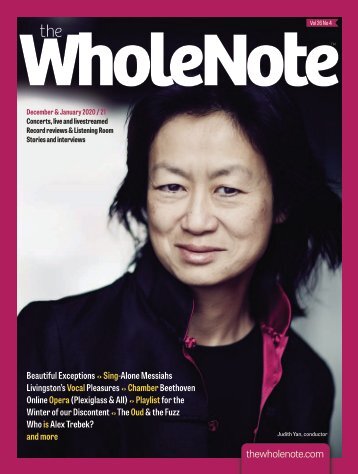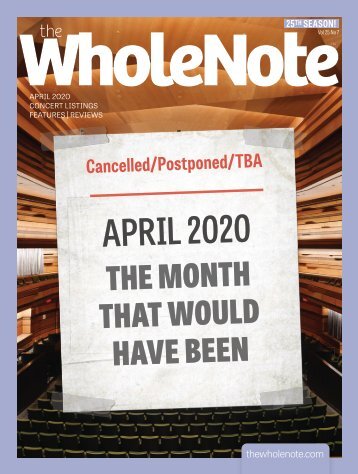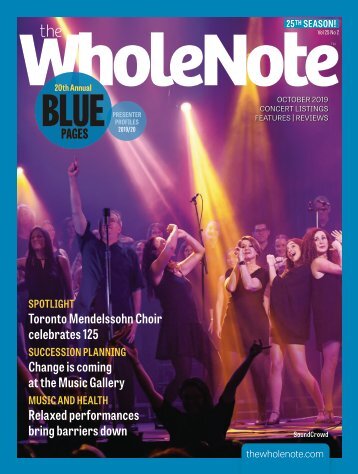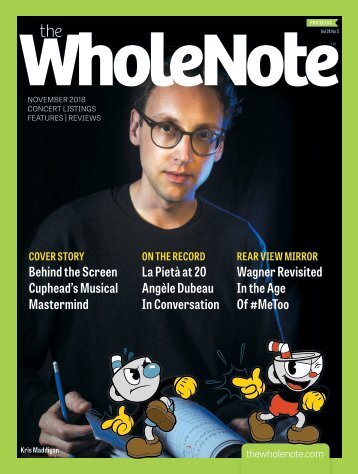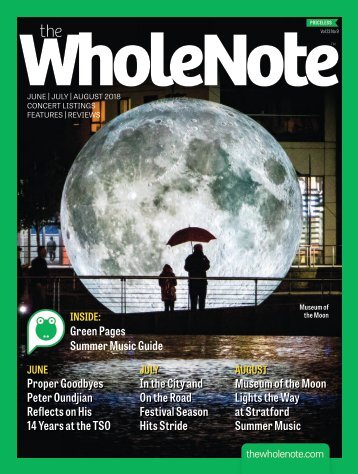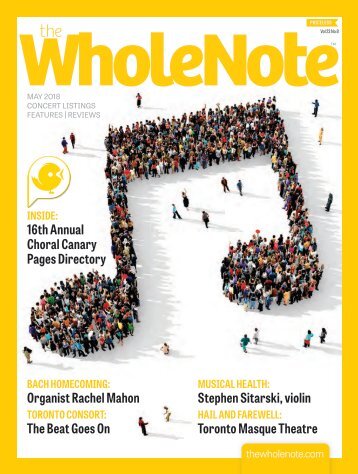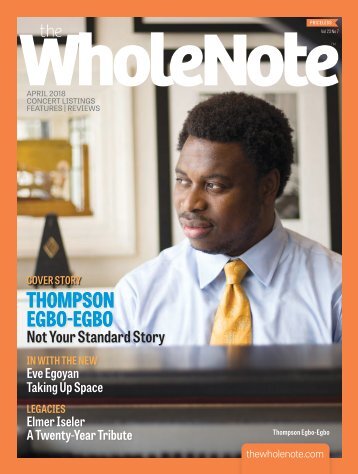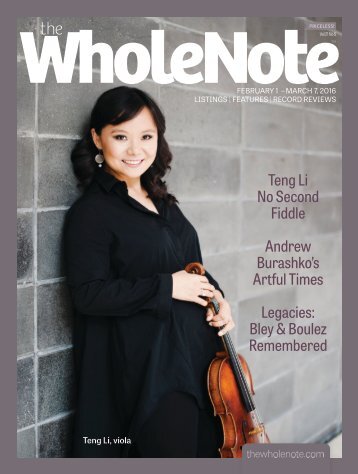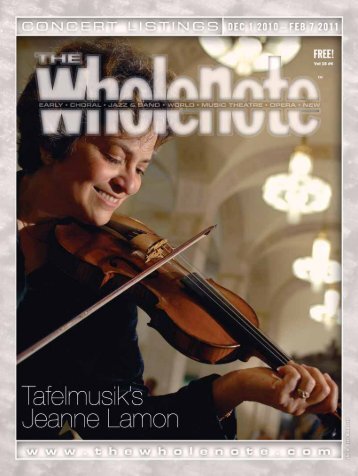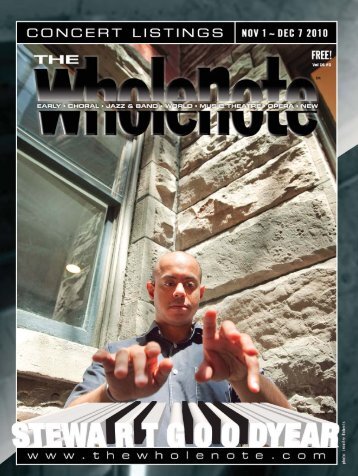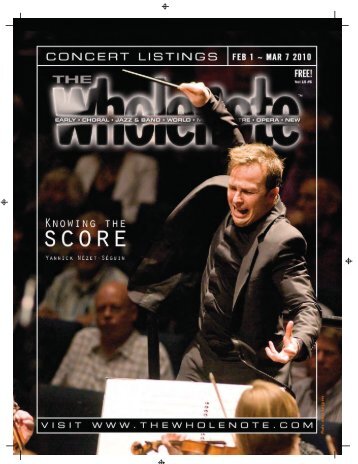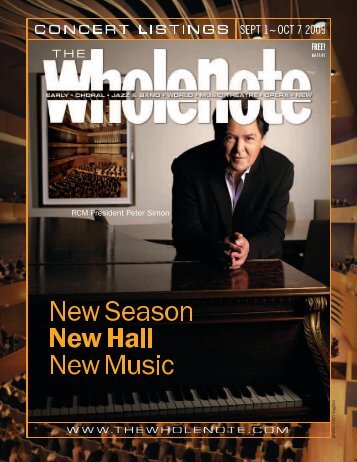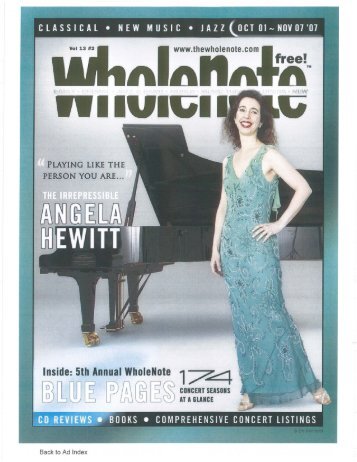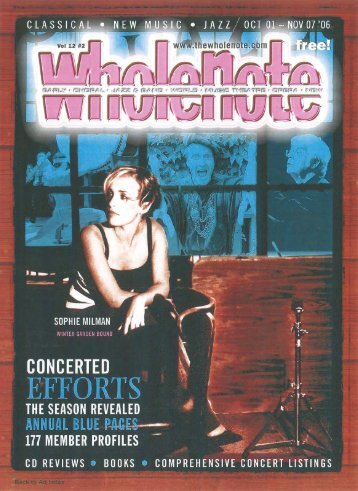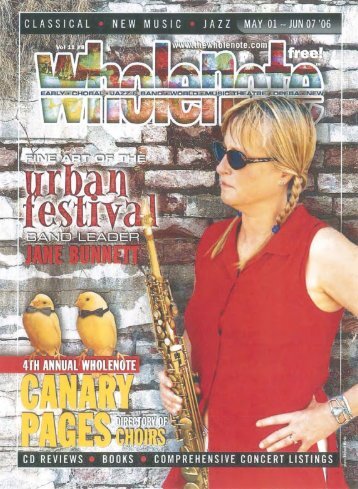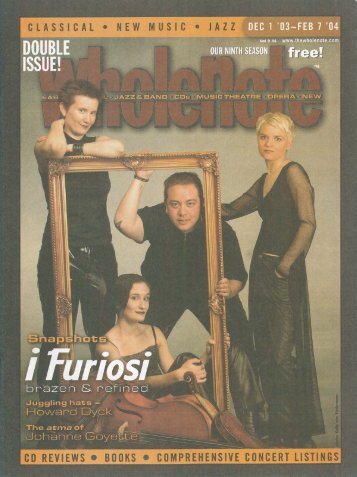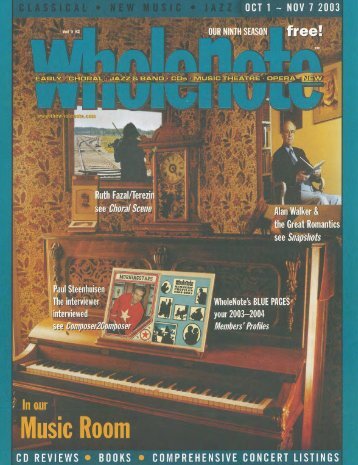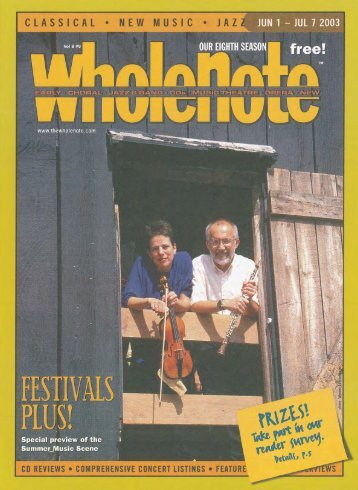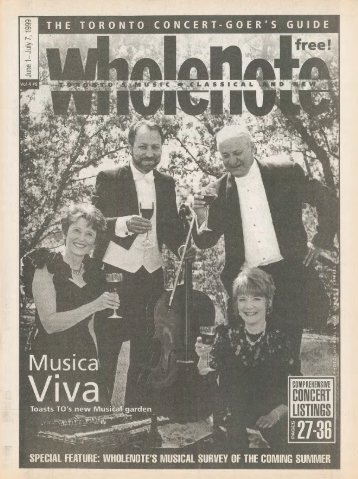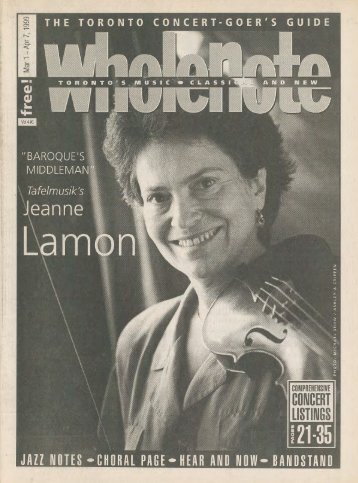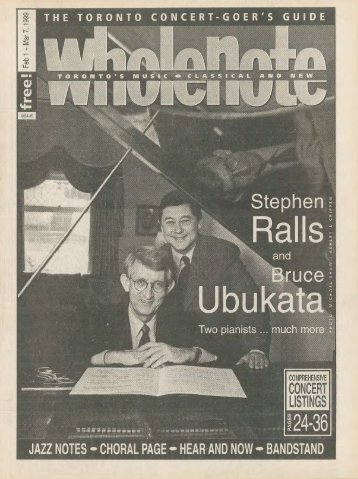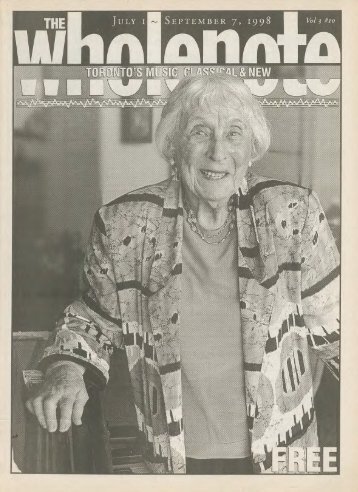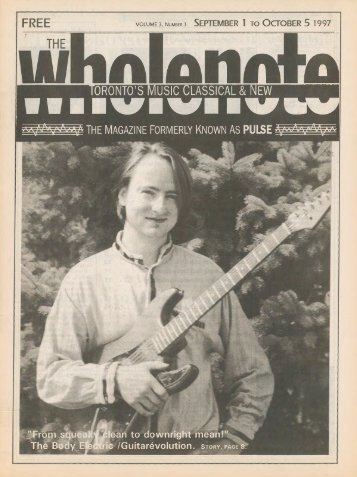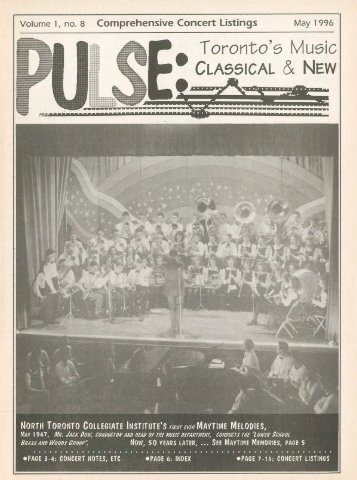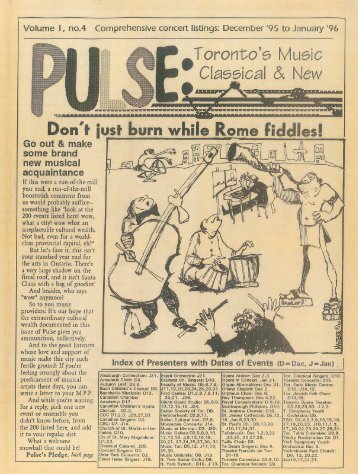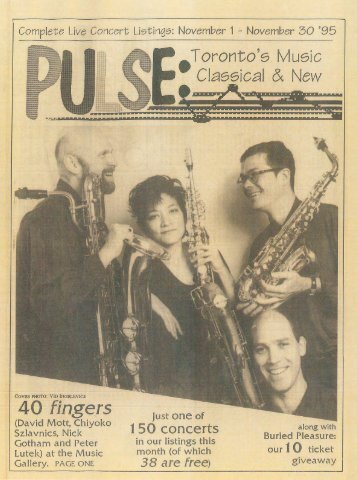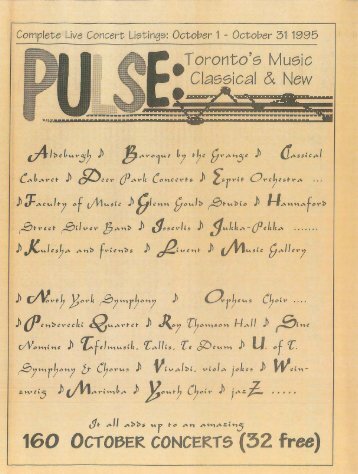Volume 24 Issue 2 - October 2018
- Text
- October
- Toronto
- Arts
- Choir
- Jazz
- Musical
- Concerts
- Performing
- Orchestra
- Theatre
Presenters, start your engines! With TIFF and "back-to-work" out of the way, the regular concert season rumbles to life, and, if our Editor's Opener can be trusted, "Seeking Synergies" seems to be the name of the game. Denise Williams' constantly evolving "Walk Together Children" touching down at the Toronto Centre for the Arts; the second annual Festival of Arabic Music and Arts expanding its range; a lesson in Jazz Survival with Steve Wallace; the 150 presenter and performer profiles in our 19th annual Blue Pages directory... this is an issue that is definitely more than the sum of its parts.
the liner notes: the
the liner notes: the autobiographical nature of the compositions played here. Exile and the search for a home are recurring narratives. And it’s the orchestral flute which takes centre stage in many of the five works here, serving as the composer’s voice. The flute is also the listener’s guide through Samandari’s life journey, connecting his old and new worlds. My favourite moments on the album are in the lonely, expressive and virtuoso flute solos of Apogee (2005) and the very substantial 16-minute Nuclide (2014), both sparkling played by Takeshi McGregor. These works belong in the Canadian flute solo playbook. Samandari’s moto is “Unity in Diversity.” We get a sense of his personal peregrinations from Iran to Canada’s west coast in Apogee. Andrew Timar Curio Box – Berio; Hindemith; Underhill Ariel Barnes; Fides Krucker; Turning Point Ensemble; Owen Underhill Orlando Records OR 0037 (orlando-records.com) !! This disc is a standout, with terrific performances and a compelling program of works, all confronting the relationship between the past and the present. In Kammermusik No.3 from 1925, German composer Paul Hindemith looks back to the Baroque, especially to Bach’s Brandenburg Concertos. The Vancouver-based Turning Point Ensemble, under Owen Underhill’s direction, handles the inventive contrapuntal textures with stylish buoyancy, while Canadian cellist Ariel Barnes brings out Hindemith’s lyrical side. Barnes’ restraint with vibrato and Romantic phrasing is especially appropriate to Hindemith, an accomplished violist who was deeply involved in historical performance practices. At the same time that avant-garde Italian composer Luciano Berio was creating his pioneering experimental works like Sinfonia, he was working on arrangements – and rearrangements – of music of the past, from Monteverdi to Puccini. In Folk Songs, from 1964, he creates altogether new accompaniments for traditional folk tunes (plus a few composed songs) from around the world. The result is an extraordinary mélange of styles and harmonic languages. Canadian vocalist Fides Krucker’s blazing theatricality and playful brilliance put her in the same league as the fabulous American singer Cathy Berberian, who premiered this work. Canadian composer and conductor Underhill’s own Cello Concerto from 2016 takes us through the fragmentation and reassembling of memories of the past, triggered by a Chinese curio box full of precious objects. The virtuosic, responsive Turning Point Ensemble under Underhill’s precise direction creates evocative, colourful interplay with Barnes’ adventurous and dramatic cello playing. I enjoyed the anecdotal liner notes and bios, but I do wish there were texts for the songs – with translations. Pamela Margles Shostakovich – Symphonies Nos. 4 & 11 “The Year 1905” Boston Symphony Orchestra; Andris Nelsons Deutsche Grammophon 80028595-02 (deutschegrammophon.com) !! It says here there was no greater symphonist of the 20th century than Shostakovich. Don’t @ me, as they say on Twitter. This DG recording of the Boston Symphony, led by Andris Nelsons, is part of their ongoing project to record the complete cycle by the beleaguered Russian artist. The story behind his Symphony No.4 is relevant to any reading of the piece, although much too involved to fully recount here. Suffice it to say he fell into sudden disfavour with Stalin while working on it, and finally chose to withdraw the work before its premiere. The move, while an illustration of how little freedom an artist had during the era, likely saved the composer from exile to the Gulag. (An excellent fuller version of the story is available here: michaellewanski.com/blog/2014/10/8/shostakovich-symphony-no-4-in-c-minor-op-43). Too many adjectives can attach to the puzzling work: at turns horrifying, melodramatic, sarcastic, madcap, maudlin, macabre, morose. Shostakovich might have been passing a note to his compatriot colleagues like Alfred Schnittke and Edison Denisov: “Here is as far as you can go, and not in any safety.” Nelsons wrings a full accounting of the hair-raising piece, all 65 minutes of it, from the redoubtable BSO musicians. I defy anyone to listen to James Somerville’s horn playing here without feeling simultaneously uplifted and devastated. The second half of the two-disc release makes a curious pairing. Symphony No.11 was composed more than two decades later in 1957, followed an overt “program” in depicting the events of the brutally quashed 1905 Russian workers’ uprising, and was written to satisfy a government-mandated (“suggested”) recognition of the 40th anniversary of the 1917 revolution. Perhaps the idea is to contrast the work of a brash young idealist, an artist who believed he was free, to the more mature output of one who knew he never would be. Clearly in his music he felt the humanity of those starving workers, murdered a half-century earlier by a despot. There are subtexts to all of his music, and the question remains about whether this symphony reflected the composer’s views about more recent crimes. Programmatically structured to the point of pedantry, it is nonetheless brilliantly played. Hearing these excellent players gives the heart ease. Max Christie Trio Clavio Trio Clavio ArcoDiva UP 0204 (arcodiva.cz) ! ! Established with the help of Polish clarinetist/ conductor Jakub Bokun in 2013, this Czech trio has been performing as Trio Clavio since its successful debut at Wrocław, Poland’s Clarimania Festival. The three talented members – pianist Lucie Soutorová Valčová, violinist Lucia Fulka Kopsová and clarinetist Jana Černohouzová – are each superstar soloists and chamber musicians. In their debut self-titled two-CD release, they demonstrate solid technique, musicality, ensemble playing, personal musical risk-taking, integrity, and the joy of performing music. CD One has these younger-generation musicians playing music by three 20th-century composers. Highlights from Stravinsky’s trio suite from L’Histoire du soldat include colourful low and high pitches, clear articulation of individual notes, and mood-making intense playing, especially at the almost spooky Danse du Diable closing. Bartók’s threemovement Contrasts features a tighter fullorchestra sound, with classic Bartók dramatic musical conversations between the instruments. Paul Schoenfield’s Trio for Clarinet, Violin & Piano is a four-movement, Jewishbased work. The opening Freylakh has a nice klezmer feel, especially in the held violin and clarinet notes. March opens with exciting lowpitched mysterious piano notes and ascending and descending glissandos, leading to subsequent virtuosic trio performance. Nigun is a fugal klezmer piece and the final Kozatske is an exciting fast klezmer-flavoured movement. CD Two showcases diverse works by living composers. Love Czech Lukáš Hurník’s witty work, Alphabet. After a short introduction, each capital letter of the alphabet is given a musical score resulting in a piece packed with diverse ideas and sounds. E is a fugue with three instruments emulating its three horizontal lines; D is all played on the violin D string; G is brought to sound life with a florid piano line. Czech Martin Brunner composed his self-described childishly playful Like Children while thinking of trio-member Valčová’s son. The three movements delight with touches of lullaby, reflection and running-around sounds. Trio Clavio 74 | October 2018 thewholenote.com
commission “Chiaroscuro” Trio by Slovak Juraj Filas is a single-movement, tonal, expressive, Romantic-flavoured sonata reminiscent of film music, including subtle and sudden dramatic musical shifts from loud rhythms to slower reflective sections, high pitches and lengthy held notes. Closing is Czech Sylvie Bodorová’s Vallja e malit “Dancing Mountain,” a folk-music rooted work with a tight Ballata opening, and a faster, closing, toe-tapping, intense, rapid line-filled Danza movement. Trio Clavio is musically wonderful, unique and breathtaking in all they play! Tiina Kiik JAZZ AND IMPROVISED Clips Brodie West Quintet Independent LORNA/011 (brodiewest.com) !! In the world of scientific laboratories, an experiment is defined as “a procedure carried out to support, refute, or validate a hypothesis.” Experiments provide insight into cause and effect by demonstrating what outcome occurs when a particular factor is manipulated. Experiments vary greatly in goal and scale, but always rely on repeatable procedure and logical analysis of the results. However, in music the word experimentation ought not to exist, as no scientifically repeatable procedure can be used to support, refute, or validate its hypotheses. The music of the Brodie West Quintet validates its constructs with magic and mystery, both becoming the quintessence of their improvisational musical world. Truth be told, when it comes to West and his music – particularly on Clips – mystery and magic all collide in one unscientifically glorious big bang, producing art that always defies and blurs any categories. The alto saxophonist continues to destroy the proverbial artificial walls erected in music. Goal and scale are tossed into the unknown with the wickedly intense scope of the music on Clips. The fractured rhythms of the radiantly irreverent Prel and Fug are an exemplary experience of the sparkling wit and ingenuity of West’s yammering melodic and harmonic conceptions. The saxophonist also draws into this musical web pianist Tania Gill, bassist Josh Cole and the drummers Nick Fraser and Evan Cartwright. Together they penetrate West’s riddle-filled music at a deeper level, creating art that’s radically fresh and intuitive, and plucked as if from ether. Raul da Gama Seldom in the Well Chris Monson Independent (chrismonson.bandcamp.com) !! Chris Monson’s debut album, Seldom in the Well, showcases his original jazz compositions while maintaining the stylish 60s feel. At times it is reminiscent of Blue Note records from that period, with a subtle rhythmic drive and touch of sultriness. It also features a stellar sextet – Monson on guitar, Kelly Jefferson on tenor saxophone, Kevin Turcotte on trumpet/flugelhorn, Anthony Panacci on piano, Artie Roth on acoustic bass and Tom Rasky on drums. Monson’s early roots in progressive rock are not necessarily obvious here; rather, his arrangements are an intricate map of sounds and stories. The album opens with the rich-sounding Where the Leaf Has Been, a sonic hint of what is to come. That hint is revealed perfectly in my favourite tune on the album, Distant. Solid. Figures. As I was listening to it with my headphones, I was immersed in the sounds constantly moving from the left to the right in some sections – it was incredibly intimate and engaging. The Passing Through finally showcases Monson’s funky guitar grooves and his taste for understated melodies. Although he often takes a backseat, allowing each of his fellow musicians to shine, Monson maintains constant rhythmic conversations with the piano. As a matter of fact, many of the subtle rhythm hooks are this album’s gems. If We Dreamed of Soaring features another jewel – the bowed bass solo, so unexpected and so beautiful that it makes this music come full circle. Seldom in the Well has a combination of aural density and airiness that appeals to both seasoned jazz listeners and novices in the genre. Recommended. Ivana Popovic Kinship John Pittman; Shirantha Beddage; Jeff McLeod; Mike Downes; Curtis Nowosad Slammin Media SMO001 (pittmanmusic.com) !! Released on August 24 through the Torontobased company Slammin’ Media, Kinship is the debut solo release from trumpeter/ composer John Pittman. Pittman is a veteran member of the Heavyweights Brass Band – probably Toronto’s best-known New Orleans-style horn ensemble – and he has been a mainstay on the local scene for some time, performing with a wide range of musical artists. Pittman is joined on this outing by baritone saxophonist Shirantha Beddage, pianist Jeff McLeod, bassist Mike Downes and drummer Curtis Nowosad, all of whom share some degree of personal history with Pittman; the concept of kinship, as Pittman writes in his liner notes, is “at the heart of this album.” Kinship starts with the up-tempo Ties That Bind, an exciting piece that sets the tone for the rest of the album, both musically and thematically. For Siobhan – written by Pittman for his wife – is a bouncy, backbeat-driven affair, with solid rhythm section playing, and Homio-stasis, a satisfying, swinging song, is as close to a standard as Kinship gets, featuring a blistering muted solo from Pittman and an articulate, lyrical contribution from Downes. Of the album’s eight songs, only two are covers: As, the Stevie Wonder classic, and Where Is The Love?, from the catalogue of the Black Eyed Peas. Throughout Kinship, Pittman’s trumpet is strong, athletic and mature, and – much like his arrangements – displays a winning combination of hard bop, New Orleans and modern jazz influences. Colin Story When Day Slips Into Night University of Toronto 12TET UofT Jazz (uoftjazz.ca) Explosion Cory Weeds Little Big Band Cellar Live CL111317 (cellarlive.com) ! ! Jazz comes in many sizes including solo, trio, quartet and big band; Cory Weed’s Little Big Band’s Explosion, and the University of Toronto 12tet’s When Day Slips Into Night, are newly released examples of the “small big band” format. This size allows a large sonic palette while having a more flexible group to work with (a famous example is the Miles Davis Nonet that played on Birth of the Cool). Explosion is the work of professional musicians from Vancouver, Edmonton and New York. When Day Slips Into Night is the product of the University of Toronto’s jazz performance program and contains a mix of undergraduate and graduate performers and arrangers. Explosion is full of great music and performances, and the comprehensive liner notes by Chris Wong provide context to the album’s development and its individual tracks. Longtime Vancouver saxophonist (and former jazz club owner) Cory Weeds organized the group and commissioned Jill Townsend and Bill Coon to write the arrangements of the songs he chose. All thewholenote.com October 2018 | 75
- Page 1 and 2:
PRICELESS Vol 24 No 2 OCTOBER 2018
- Page 3 and 4:
2018/19 Season VIVALDI CON AMORE Di
- Page 5 and 6:
2402_OctCover.indd 1 PRICELESS Vol
- Page 7 and 8:
FOR OPENERS | DAVID PERLMAN WHO STO
- Page 9 and 10:
Walk Together Children, one of her
- Page 11 and 12:
AGA KHAN MUSEUM PERFORMING ARTS PRE
- Page 13 and 14:
An agency of the Government of Onta
- Page 15 and 16:
concerts featured the Zhejiang Symp
- Page 17 and 18:
out of the blue, we’d spend the e
- Page 19 and 20:
Nineteen years ago, you told Allan
- Page 21 and 22:
Beat by Beat | Classical & Beyond T
- Page 23 and 24:
´ Beat by Beat | On Opera Wainwrig
- Page 25 and 26:
COC (from left) Composer Rufus Wain
- Page 27 and 28:
Dorabella in the COC revival of Ato
- Page 29 and 30:
Vesnivka Choir in concert in Senlis
- Page 31 and 32:
St. Michael’s Cathedral Basilica
- Page 33 and 34:
Anandi Bhattacharya So Long Seven l
- Page 35 and 36:
TAMARA ABDUL HADI most highly regar
- Page 37 and 38:
Elinor Frey presents a program of n
- Page 39 and 40:
Herbie Nichols and fearless individ
- Page 41 and 42:
and strength in the other’s under
- Page 43 and 44:
19 TH ANNUAL BLUE PAGES PRESENTER P
- Page 45 and 46:
composers through a self-produced T
- Page 47 and 48:
The band’s 2018/2019 subscription
- Page 49 and 50:
●●Chorus Niagara Worth the driv
- Page 51 and 52: Through EUTERPE (www.euterpemusicar
- Page 53 and 54: ●●Harbourfront Centre For more
- Page 55 and 56: jnarveso@uwaterloo.ca www.k-wcms.co
- Page 57 and 58: Kayla McGee 416-204-1080 kayla@musi
- Page 59 and 60: music director Denis Mastromonaco a
- Page 61 and 62: and cultural background, analysing,
- Page 63 and 64: ●●Syrinx Concerts Toronto Syrin
- Page 65 and 66: Mozart’s Requiem. Lawrence Peddie
- Page 67 and 68: 905-953-5122 vpanconcerts-newmarket
- Page 69 and 70: BLUE PAGES 2018/19 SECTION II: ARTS
- Page 71 and 72: A. Concerts in the GTA The WholeNot
- Page 73 and 74: 65 Church St. 416-364-7865. Free.
- Page 75 and 76: ●●8:00: Jazz Bistro. CD Release
- Page 77 and 78: ●●3:00: Windermere String Quart
- Page 79 and 80: ●●7:30: Flute Street. Masterpie
- Page 81 and 82: ●●8:00: Royal Conservatory. Dan
- Page 83 and 84: 270 King St. E., Kingston. 613-548-
- Page 85 and 86: Sun(2pm), Wed-Sat(7:30pm). ●●Dr
- Page 87 and 88: It also seems important to note, fo
- Page 89 and 90: ext 155. ●●Oct 14 10:30am-5:30p
- Page 91 and 92: MUSICAL LIFE OPERA LOVE: A CASE FOR
- Page 93 and 94: DISCOVERIES | RECORDINGS REVIEWED D
- Page 95 and 96: STRINGS ATTACHED TERRY ROBBINS The
- Page 97 and 98: Keyed In ALEX BARAN Christina Petro
- Page 99 and 100: Chansons d’amour d’Acadie et de
- Page 101: But the ultimate appeal for this ne
- Page 105 and 106: counterpoint to a lead voice. In al
- Page 107 and 108: assy part of the horn’s output an
- Page 109 and 110: v JOIN THE TMC FOR A SEASON OF CHOR
- Page 111 and 112: A OF NOV.01.18 Experience the count
Inappropriate
Loading...
Mail this publication
Loading...
Embed
Loading...
























